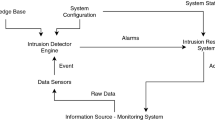Abstract
With the growth and benefits of network usage, securing the networks by using anomaly intrusion detection systems (IDS) against unknown intrusions has become an important issue. The first step of protecting any network is the detection of attacks. In this paper, we concentrate on four attacks; denial of service (DoS), probing, remote-to-local, and user-to-root attacks. We depend on features extracted from (NSL-KDD) dataset for these attacks. We investigate the performance of the attack detection process for several numbers of features using various subset-based feature selection techniques aiming to find the optimum collection of features for detecting each attack with an appropriate classifier. Simulation results reveal that redundant features can be eliminated from the attack detection process, and that we can determine the most useful set of features for a certain classifier, which enhances the IDS performance.

Similar content being viewed by others
References
Sen, S. (2015). Chapter 4: A survey of intrusion detection systems using evolutionary computation. In X. S. Yang, S. F. Chien, & T. O. Ting (Eds.), Bio-inspired computation on telecommunication (pp. 73–94). Burlington: Morgan Kaufmann.
Tavallaee, M., Bagheri, E., Lu, W., & Ghorbani, A. (2009). A detailed analysis of the KDD CUP 99 data set. In: Second IEEE symposium on computational intelligence.
http://www.unb.ca/cic/datasets/nsl.html. Accessed 11 April 2016.
Elrawy, M. F., Abdelhamid, T. K., & Mohamed, A. M. (2013). IDS in telecommunication network using PCA. International Journal of Computer Networks & Communications (IJCNC), 5(4), 147–157.
Zargar, G., & Baghaie, T. (2012). Category-based intrusion detection using PCA. Journal of Information Security, 3, 259–271.
www.softcomputing.net. Accessed August 1, 2015.
Liu, H. W., Suna, J. G., Liu, L., & Zhang, H. J. (2009). Feature selection with dynamic mutual information. Pattern Recognition, 42, 1330–1339.
Liu, H., Motoda, H., Setiono, R., & Zhao, Z. (2010). Feature selection: An eve evolving frontier in data mining. In: JMLR: Workshop and conference proceedings (Vol. 4, pp. 4–13). Publisher Citeseer.
Hall, M. (1999). Correlation based feature selection for machine learning. In: Doctoral dissertation, Department of Computer Science, University of Waikato.
Thanah, H., Franke, K., & Pertovic, S. (2012). Chapter 2: Feature extraction methods for intrusion detection systems. In M. Gupta (Ed.), Threats countermeasures and advances in applied information security (pp. 23–52). IGI Global: Hershey.
Vege, S. H. (2010). Ensemble of feature selection techniques for high dimensional data. Published Master’s thesis, Western Kentucky University.
Wang, Y., & Makedon, F. (2004). Application of relief feature filtering algorithm to selecting informative genes for cancer classification using microarray data. In: Computational systems bioinformatics conference, IEEE (pp. 497–498).
Neethu, B. (2013). Classification of intrusion detection dataset using machine learning approaches. IJECSE, 1, 1044–1051.
Garge, T., & Kumar, Y. (2014). Combinational feature selection approach for network intrusion detection system. In: International conference on parallel (pp. 82–87).
Author information
Authors and Affiliations
Corresponding author
Additional information
Publisher’s Note
Springer Nature remains neutral with regard to jurisdictional claims in published maps and institutional affiliations.
Rights and permissions
About this article
Cite this article
Ghazy, R.A., EL-Rabaie, ES.M., Dessouky, M.I. et al. Efficient Techniques for Attack Detection Using Different Features Selection Algorithms and Classifiers. Wireless Pers Commun 100, 1689–1706 (2018). https://doi.org/10.1007/s11277-018-5662-0
Published:
Issue Date:
DOI: https://doi.org/10.1007/s11277-018-5662-0




